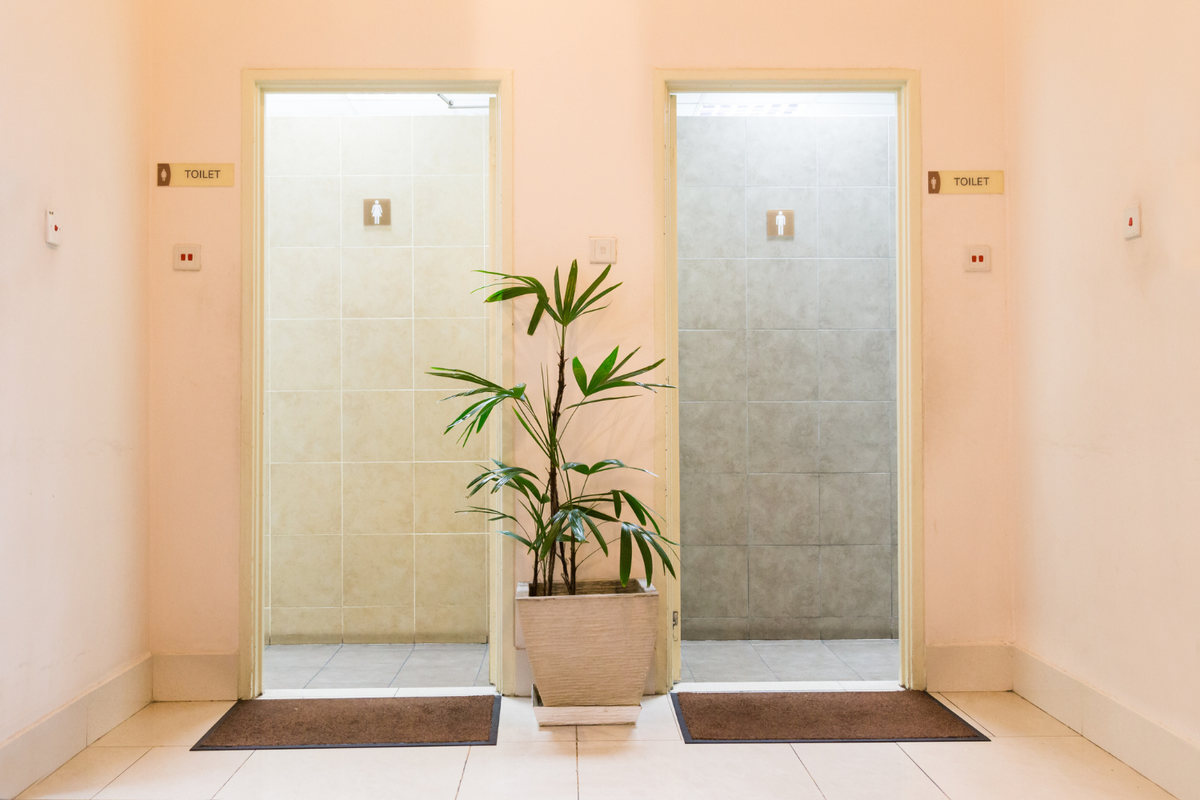 FREE UK DELIVERY.
EXPRESS OPTIONS AVAILABLE
FREE UK DELIVERY.
EXPRESS OPTIONS AVAILABLE

Washroom Door Sizes: Essential Guidelines for Optimal Functionality
|
|
Time to read 7 min
 FREE UK DELIVERY.
EXPRESS OPTIONS AVAILABLE
FREE UK DELIVERY.
EXPRESS OPTIONS AVAILABLE
 UP TO 10 YEARS GUARANTEE
FOR PEACE OF MIND
UP TO 10 YEARS GUARANTEE
FOR PEACE OF MIND
 30 DAY RETURNS
NO QUIBBLE GUARANTEE
30 DAY RETURNS
NO QUIBBLE GUARANTEE
|
|
Time to read 7 min
Table of Contents
Standard UK washroom door sizes balance privacy and accessibility.
Door dimensions affect bathroom layout and functionality.
Building codes and accessibility needs influence door size choices.
When planning a bathroom renovation or new build, getting washroom door sizes right is crucial. You might think all doors are the same, but bathroom doors have unique requirements. They need to balance privacy, accessibility, and space efficiency.
The standard door size for a bathroom in the UK is typically 860mm wide and 1981mm tall. This size works well for most homes, providing enough space for comfortable entry and exit. But it's not a one-size-fits-all situation. Some bathrooms may need wider door openings for wheelchair access, while others might require narrower doors to fit small bathrooms.
Choosing the right internal door isn't just about measurements. You need to consider factors like the door's swing direction, the layout of your bathroom, and local building regulations. These elements all play a part in creating a functional and compliant bathroom space.
Bathroom door sizes vary based on location and building regulations. The right dimensions ensure comfort, accessibility, and compliance with local codes.
In the UK, standard door sizes typically range from 1981mm to 2032mm in height. The width can vary from 610mm to 762mm.
UK regulations suggest a clear door opening width of at least 775mm for wheelchair access, which usually translates to a door that is at least 838mm (33 inches) wide when considering the frame and swing space.
Building regulations in the UK play a crucial role in determining washroom door sizes. Approved Document M of the UK Building Regulations stipulates that for accessible bathrooms, the minimum clear door opening width should be 775mm, which usually translates to a door width of 838mm or more.
For general bathroom doors in new builds or when retrofitting for accessibility, wider doors are recommended. For example, doors with a clear door opening width of 900mm (35.4 inches) provide greater accessibility and ease of use for individuals with mobility aids.
To ensure your commercial space complies with these requirements, review the legal requirements for workplace toilets in the UK.
Accessible washroom doors are crucial for ensuring everyone can use facilities comfortably and safely. They must meet specific size requirements to accommodate various mobility needs.
Universal design principles aim to create environments usable by all people without the need for adaptation. When it comes to washroom doors, key points include:
A minimum clear width of 775mm (31 inches) when open.
Easy to operate with one hand.
No more than 20 Newtons of force to open.
Lever handles instead of knobs.
These features benefit not just wheelchair users but also parents with prams, people carrying packages, and those with temporary injuries.
For wheelchair accessibility, washroom doors need specific dimensions:
Minimum clear opening width of 775mm (31 inches) as per Approved Document M.
Maximum threshold height of 15mm (0.6 inches).
Manoeuvring space on both sides of the door.
Remember, these are minimum requirements. Wider doors, such as 36 inches (914 mm), provide even better access and comfort for all users.
The material of your washroom door influences both function and design. Consider these options:
Wood doors: Offer a classic look with various finishes but may warp in humid environments.
Glass doors: Provide a modern, open feel and are easy to clean, though they require maintenance to prevent water spots. Frosted glass adds privacy while letting light in.
Metal doors: Durable and moisture-resistant, ideal for high-traffic areas. Stainless steel gives a sleek, contemporary touch.
In high-traffic environments, selecting a durable material like stainless steel is essential. Commercial washrooms may also benefit from installing commercial showers and commercial taps for added functionality and durability.
To further enhance your commercial bathroom’s functionality, check out our guide on choosing the best commercial shower fixtures, which complement your washroom's design and practicality.
Safety is crucial in washroom design. Door edges should be smooth to prevent injury. Consider soft-close hinges to avoid finger traps. Locks are essential for privacy. Choose locks that are easy to use but can be opened from outside in emergencies. Sliding locks or push-button systems are perfect options.
For shared bathrooms, consider doors with occupancy indicators. These show if the room is in use without compromising privacy.
For commercial properties, consider installing automatic or touch-free doors in washrooms. These doors enhance hygiene, reduce the spread of germs, and improve accessibility for all users, particularly in busy environments such as shopping centres, airports, and healthcare facilities.
Ensure the door swing doesn't block access to sinks or other fixtures. A well-planned layout enhances safety and usability.
Choosing between sliding and hinged doors depends on your bathroom's size and style. Here's a breakdown of each option:
Sliding doors: Ideal for small bathrooms as they save space and add a modern touch. Pocket doors, which slide into the wall, free up even more floor space.
Hinged doors: A classic choice that swings open, best for larger bathrooms. French doors, especially with glass panels, add a touch of elegance.
Panel doors: Offer a traditional look with various designs available to match your style. For a contemporary vibe, frosted glass doors are a popular option, allowing light through while maintaining privacy.
Wood doors: Add warmth to your bathroom and come in a range of finishes. They can also be painted to fit your bathroom’s colour scheme.
The layout should allow space for fixtures such as the sink and toilet, so the door doesn't block access to these essential features. For further washroom upgrades, consider pairing your door choice with premium shower sets or bathroom taps to create a cohesive, stylish look.
The right accessories can make your bathroom door more functional. Door handles should be easy to grip, even with wet hands. Choose finishes that match your bathroom's other metals.
Locks are important for privacy. You can opt for simple thumb turns or more secure options. For families, consider locks that can be opened from the outside in emergencies.
Door stops protect your walls from damage. They come in floor-mounted or wall-mounted styles. Some even double as handy hooks for towels or robes.
Door width is crucial, especially for accessibility. Standard doors are usually 28-32 inches wide. For wheelchair access, you'll need at least 32 inches of clear space.
Choosing the right washroom door size is an essential part of creating a functional and accessible space, whether for residential or commercial use.
By considering factors like door width, materials, and compliance with UK regulations, you can ensure your bathroom is both stylish and practical. Every detail counts in designing a space that feels comfortable and works seamlessly.
For all your bathroom needs, House of ENKI offers a wide selection of premium taps, showers, and accessories to complement any washroom design. Browse our collections at House of ENKI or get in touch for expert advice and to find the perfect fixtures for your project.
Bathroom door sizes in the UK follow certain standards and guidelines. Let's explore some common questions about door dimensions for washrooms and internal spaces.
To ensure compliance with UK accessibility standards, washroom doors must have a minimum clear opening of 775mm (31 inches) and should be equipped with lever handles that are easy to operate. The door must also allow space for wheelchair manoeuvring on both sides. Consulting a compliance expert can help you meet all regulatory requirements.
To maintain hygiene in commercial washrooms, choose materials that are easy to clean and resistant to moisture. Stainless steel, glass, and laminated wood are great options. Additionally, automatic or touch-free door solutions can help reduce the spread of germs in high-use environments.
In certain commercial buildings, fire-rated doors are required by law. These doors are designed to withstand fire for a specified amount of time, usually 30 or 60 minutes, depending on the building’s fire safety requirements. Consult local fire safety guidelines to determine if your facility needs fire-rated doors.



